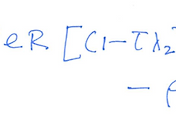We start from this equation:

And we wish to get to (under steady state* assumption)

*note: in steady state, 't' and 't+1' can be removed. eg \(h_t\) and \(h_{t+1}\) are equivalent so we can instead use \(h\) for both
Before we get started, I'll denote the following as 'STUFF', as we want to preserve that part anyway:

Likewise, \(\tau_2(1-\Omega_{t+1})\) will be denoted as 'STUFF2'
Further, as noted in the previous article, \(h_{t+1} = B E_t^\beta h_t^\alpha\), so I'll assume that substitution is made.
Let's start by rewriting the original equation.
\[ \frac{\theta_1}{\mu_2 n} = R[STUFF \times w h] - [STUFF2 w h] \]
(Note we want to get to \( \theta_1 c_2 = \rho R n \times [STUFF] - \rho n \times [STUFF2]\))
multiply \(\mu_2 n\) on both sides, which will yield:
\[\theta_1 =\mu_2 n (R[STUFF \times w h] - [STUFF2 \times w h] )\]
Then
\[\theta_1 =\mu_2 n w h (R[STUFF] - [STUFF2] )\]
Use the following fact to replace wh:

Meaning the equation is now:
\[\theta_1 =\frac{\rho \mu_2 n}{c_2 \mu_2} \times (R[STUFF] - [STUFF2] )\]
This simplifies to
\[\theta_1 =\frac{\rho n}{c_2} \times (R[STUFF] - [STUFF2] )\]
and multiplying both sides by \(c_2\),
\[\theta_1 c_2 =\rho n \times (R[STUFF] - [STUFF2] )\]
expanding it,
\[\theta_1 c_2 =\rho n R[STUFF] - \rho n[STUFF2] )\]
which is equivalent to
\[ \theta_1 c_2 = \rho R n [STUFF] - \rho n [STUFF2] \]
That we wanted to get at the start!
'Archive until 15 Jul 2021 > Economics Research' 카테고리의 다른 글
| another derivation steady state (0) | 2021.01.07 |
|---|---|
| Modelling utility of a person over 2 phases of ages (0) | 2021.01.06 |
